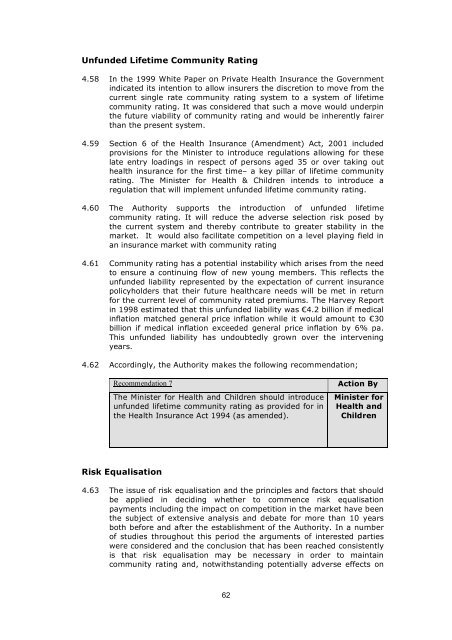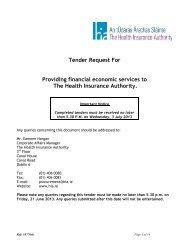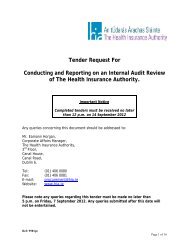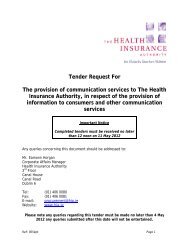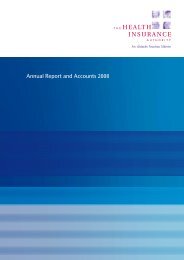Competition in the Irish Private Health Insurance Market
Competition in the Irish Private Health Insurance Market
Competition in the Irish Private Health Insurance Market
Create successful ePaper yourself
Turn your PDF publications into a flip-book with our unique Google optimized e-Paper software.
Unfunded Lifetime Community Rat<strong>in</strong>g<br />
4.58 In <strong>the</strong> 1999 White Paper on <strong>Private</strong> <strong>Health</strong> <strong>Insurance</strong> <strong>the</strong> Government<br />
<strong>in</strong>dicated its <strong>in</strong>tention to allow <strong>in</strong>surers <strong>the</strong> discretion to move from <strong>the</strong><br />
current s<strong>in</strong>gle rate community rat<strong>in</strong>g system to a system of lifetime<br />
community rat<strong>in</strong>g. It was considered that such a move would underp<strong>in</strong><br />
<strong>the</strong> future viability of community rat<strong>in</strong>g and would be <strong>in</strong>herently fairer<br />
than <strong>the</strong> present system.<br />
4.59 Section 6 of <strong>the</strong> <strong>Health</strong> <strong>Insurance</strong> (Amendment) Act, 2001 <strong>in</strong>cluded<br />
provisions for <strong>the</strong> M<strong>in</strong>ister to <strong>in</strong>troduce regulations allow<strong>in</strong>g for <strong>the</strong>se<br />
late entry load<strong>in</strong>gs <strong>in</strong> respect of persons aged 35 or over tak<strong>in</strong>g out<br />
health <strong>in</strong>surance for <strong>the</strong> first time– a key pillar of lifetime community<br />
rat<strong>in</strong>g. The M<strong>in</strong>ister for <strong>Health</strong> & Children <strong>in</strong>tends to <strong>in</strong>troduce a<br />
regulation that will implement unfunded lifetime community rat<strong>in</strong>g.<br />
4.60 The Authority supports <strong>the</strong> <strong>in</strong>troduction of unfunded lifetime<br />
community rat<strong>in</strong>g. It will reduce <strong>the</strong> adverse selection risk posed by<br />
<strong>the</strong> current system and <strong>the</strong>reby contribute to greater stability <strong>in</strong> <strong>the</strong><br />
market. It would also facilitate competition on a level play<strong>in</strong>g field <strong>in</strong><br />
an <strong>in</strong>surance market with community rat<strong>in</strong>g<br />
4.61 Community rat<strong>in</strong>g has a potential <strong>in</strong>stability which arises from <strong>the</strong> need<br />
to ensure a cont<strong>in</strong>u<strong>in</strong>g flow of new young members. This reflects <strong>the</strong><br />
unfunded liability represented by <strong>the</strong> expectation of current <strong>in</strong>surance<br />
policyholders that <strong>the</strong>ir future healthcare needs will be met <strong>in</strong> return<br />
for <strong>the</strong> current level of community rated premiums. The Harvey Report<br />
<strong>in</strong> 1998 estimated that this unfunded liability was €4.2 billion if medical<br />
<strong>in</strong>flation matched general price <strong>in</strong>flation while it would amount to €30<br />
billion if medical <strong>in</strong>flation exceeded general price <strong>in</strong>flation by 6% pa.<br />
This unfunded liability has undoubtedly grown over <strong>the</strong> <strong>in</strong>terven<strong>in</strong>g<br />
years.<br />
4.62 Accord<strong>in</strong>gly, <strong>the</strong> Authority makes <strong>the</strong> follow<strong>in</strong>g recommendation;<br />
Recommendation 7<br />
The M<strong>in</strong>ister for <strong>Health</strong> and Children should <strong>in</strong>troduce<br />
unfunded lifetime community rat<strong>in</strong>g as provided for <strong>in</strong><br />
<strong>the</strong> <strong>Health</strong> <strong>Insurance</strong> Act 1994 (as amended).<br />
Action By<br />
M<strong>in</strong>ister for<br />
<strong>Health</strong> and<br />
Children<br />
Risk Equalisation<br />
4.63 The issue of risk equalisation and <strong>the</strong> pr<strong>in</strong>ciples and factors that should<br />
be applied <strong>in</strong> decid<strong>in</strong>g whe<strong>the</strong>r to commence risk equalisation<br />
payments <strong>in</strong>clud<strong>in</strong>g <strong>the</strong> impact on competition <strong>in</strong> <strong>the</strong> market have been<br />
<strong>the</strong> subject of extensive analysis and debate for more than 10 years<br />
both before and after <strong>the</strong> establishment of <strong>the</strong> Authority. In a number<br />
of studies throughout this period <strong>the</strong> arguments of <strong>in</strong>terested parties<br />
were considered and <strong>the</strong> conclusion that has been reached consistently<br />
is that risk equalisation may be necessary <strong>in</strong> order to ma<strong>in</strong>ta<strong>in</strong><br />
community rat<strong>in</strong>g and, notwithstand<strong>in</strong>g potentially adverse effects on<br />
62


